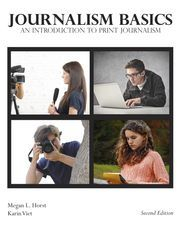Journalism Basics: An Introduction to Print Journalism presents a one-semester course for students in junior and senior high that can be used for independent study. However, meeting with a group class once a week to share writing projects should help motivate students to produce their best work. Before beginning this course, students should be able to write a well-organized paragraph, and they should have experience writing short essays. With that background, a student should find the course simple to follow.
The course begins with a foundational lesson on skills such as identifying your audience, investigating a story, and conducting an interview. Another lesson covers the AP (Associated Press) style commonly used by journalists, the use of quotes, attribution, and avoidance of plagiarism. Students will need to get a copy of the Associated Press Stylebook to use throughout the course.
The course then teaches how to write three types of pieces for a newspaper: a news story, a feature story, and an opinion piece. Succeeding lessons help students polish their writing and learn about the editing process.
Students then learn how to market their writing by searching for compatible publications and writing query letters. Finally, students each create their own newspaper with articles they have written plus headlines and pictures.
The course mentions online publications but it focuses primarily on print. While almost everything taught here applies in both situations, the digital world does have peculiarities of its own that could have been addressed in more detail. For example, blogs are mentioned on page 75 with a few comments about the style of writing used in blogs. Some tips on how to get started with a blog might have been helpful since that is a common starting point for many journalists.
Each of the course’s ten chapters includes either activities or exercises along with review questions. Most chapters have a Grammar Toolbox feature that briefly teaches a key point of grammar such as the use of commas in a series or subject-verb agreement.
Assignments and exercises vary from chapter to chapter, and some will take longer than others. For instance, the chapter on writing a news article has students work step by step through the process of writing a news article. Then they tackle the process again without this assistance to write another news story. An optional extra assignment for this same chapter has students take notes from a broadcast news report, then rewrite their own story based upon their notes. This chapter might take two weeks to complete while many other chapters can easily be completed in one week.
The process for writing the news story is mimicked for many of the other assignments. The authors walk students through the process a step at a time to make it easy for them to be successful.
Review questions check comprehension of the material taught in each chapter. A free answer key is available by email. The email address is in the front of the book along with information regarding a forthcoming, detailed teacher’s edition that will be available in 2018 (although it is not yet available as I write this review in May of 2018). While the teacher’s edition might add additional teaching tips and activities, the course should work very well without it.
In my opinion, Journalism Basics hits it just right with the appropriate amount of instruction and assistance, interesting assignments, and a manageable amount of useful writing practice.











